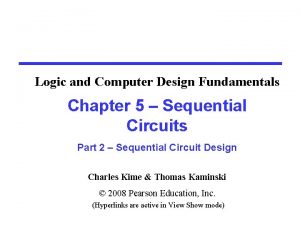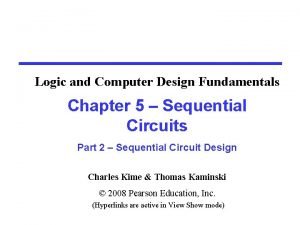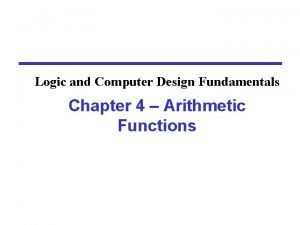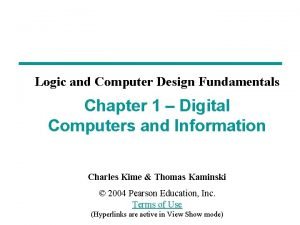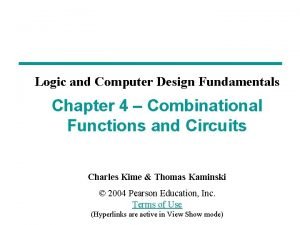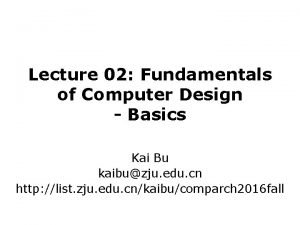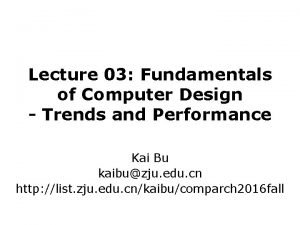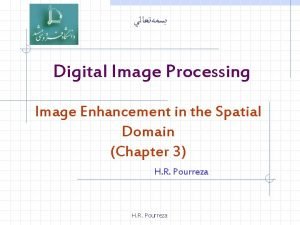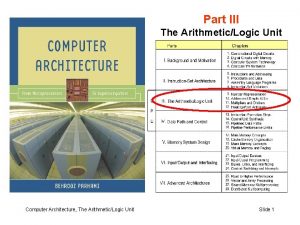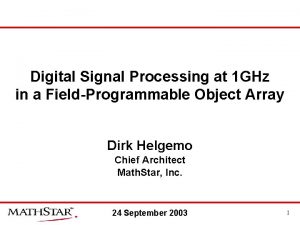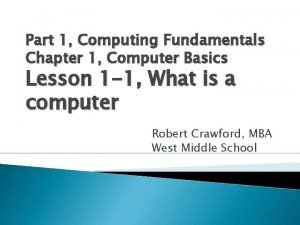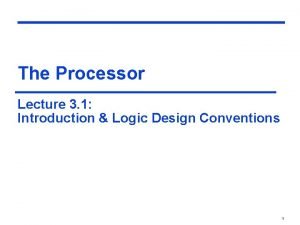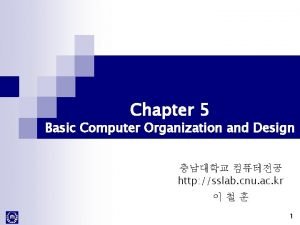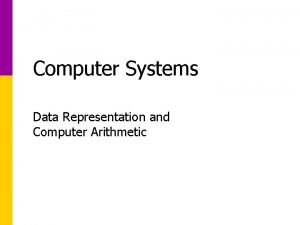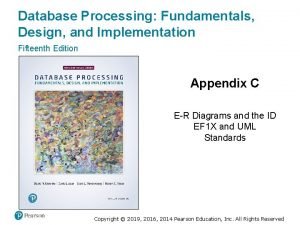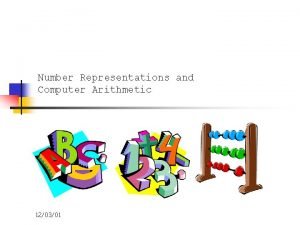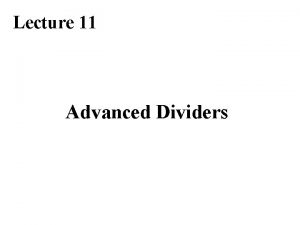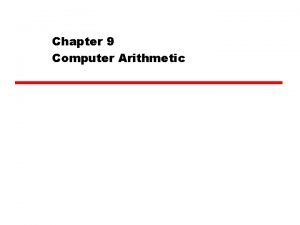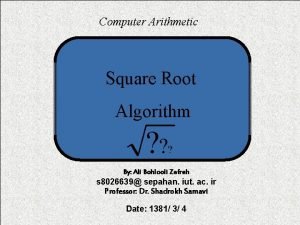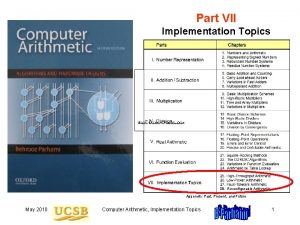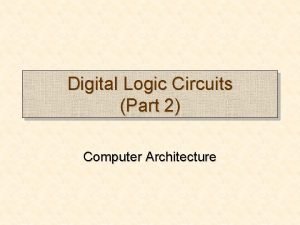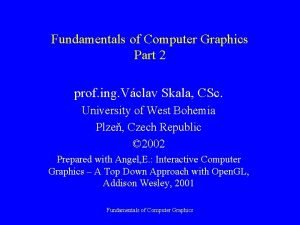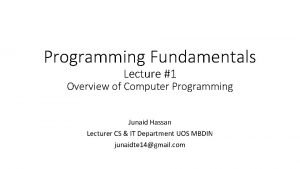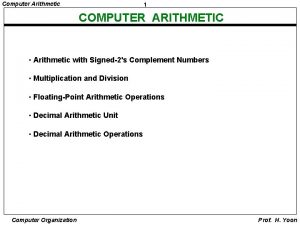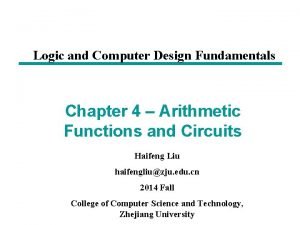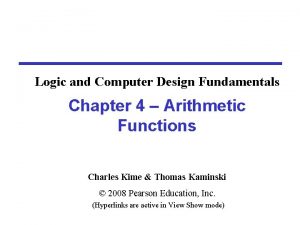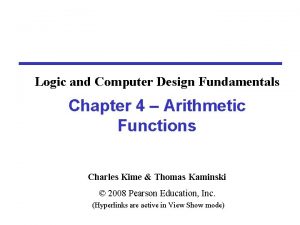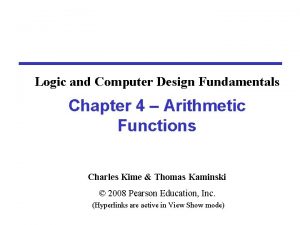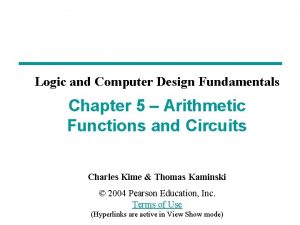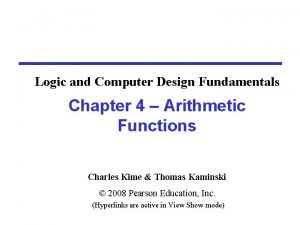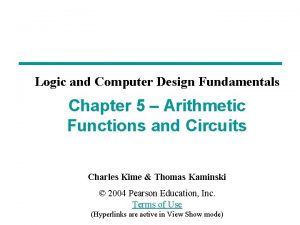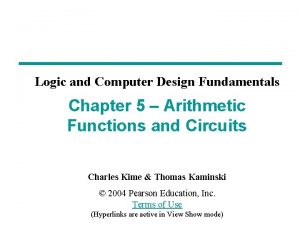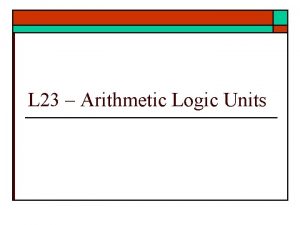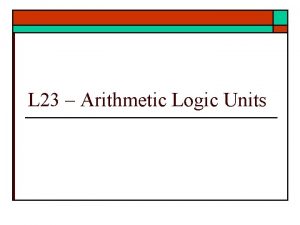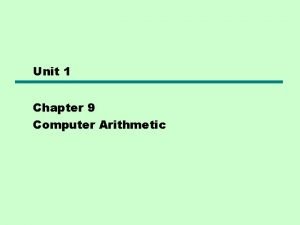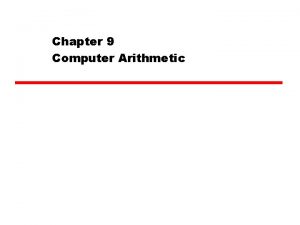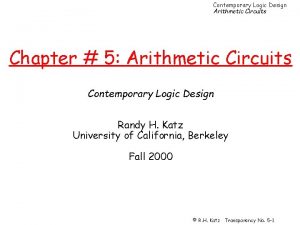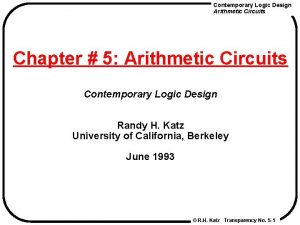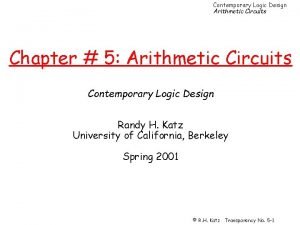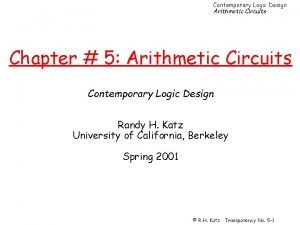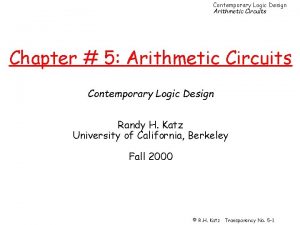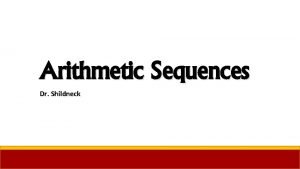Logic and Computer Design Fundamentals Chapter 4 Arithmetic









































- Slides: 41

Logic and Computer Design Fundamentals Chapter 4 – Arithmetic Functions

Overview § Iterative combinational circuits § Binary adders • Half and full adders • Ripple carry and carry lookahead adders § Binary subtraction § Binary adder-subtractors • Signed binary numbers • Signed binary addition and subtraction • Overflow § Binary multiplication § Other arithmetic functions • Design by contraction 2

Iterative Combinational Circuits § Arithmetic functions • Operate on binary vectors • Use the same subfunction in each bit position § Can design functional block for subfunction and repeat to obtain functional block for overall function § Cell - subfunction block § Iterative array - a array of interconnected cells § An iterative array can be in a single dimension (1 D) or multiple dimensions 3

Block Diagram of a 1 D Iterative Array § Example: n = 32 • • • Number of inputs = ? Truth table rows = ? Equations with up to ? input variables Equations with huge number of terms Design impractical! § Iterative array takes advantage of the regularity to make design feasible 4

Functional Blocks: Addition § Binary addition used frequently § Addition Development: • Half-Adder (HA), a 2 -input bit-wise addition functional block, • Full-Adder (FA), a 3 -input bit-wise addition functional block, • Ripple Carry Adder, an iterative array to perform binary addition, and • Carry-Look-Ahead Adder (CLA), a hierarchical structure to improve performance. 5

Functional Block: Half-Adder § A 2 -input, 1 -bit width binary adder that performs the following computations: X + Y 0 0 + 1 1 + 0 1 + 1 C S 0 0 0 1 1 0 § A half adder adds two bits to produce a two-bit sum § The sum is expressed as a X Y C S sum bit , S and a carry bit, C 0 0 § The half adder can be specified 0 1 as a truth table for S and C 1 0 1 1 0 1 1 0 6

Logic Simplification: Half-Adder § The K-Map for S, C is: S § This is a pretty trivial map! By inspection: S = X×Y+ X×Y = X Y S = ( X + Y) × ( X + Y) X C Y 0 11 12 3 X Y 0 1 2 13 § and C = X×Y C = ( ( X ×Y ) ) § These equations lead to several implementations. 7

Five Implementations: Half-Adder § We can derive following sets of equations for a halfadder: (d ) S = ( X + Y) × C (a) S = X × Y + X × Y C = ( X + Y) C = X×Y ( b) S = ( X + Y) × ( X + Y) (e ) S = X Y C = X×Y ( c ) S = ( C+ X× Y) C = X×Y § (a), (b), and (e) are SOP, POS, and XOR implementations for S. § In (c), the C function is used as a term in the AND-NOR C implementation of S, and in (d), the function is used in a POS term for S. 8

Implementations: Half-Adder § The most common half X adder implementation is: (e) S Y S = X Y C = X×Y C § A NAND only implementation is: S = ( X + Y) × C C = ( ( X ×Y ) ) X C S Y 9

Functional Block: Full-Adder § A full adder is similar to a half adder, but includes a carry-in bit from lower stages. Like the half-adder, it computes a sum bit, S and a carry bit, C. Z 0 0 • For a carry-in (Z) of X 0 0 1 1 0, it is the same as the half-adder: + Y + 0 + 1 C S 0 0 0 1 1 0 • For a carry- in Z 1 1 (Z) of 1: X 0 0 1 1 + Y + 0 + 1 C S 0 1 1 10

Logic Optimization: Full-Adder § Full-Adder Truth Table: X Y Z 0 0 0 1 1 1 0 0 1 1 1 § Full-Adder K-Map: S Y 0 X 14 11 3 5 17 Z C 12 6 Y 0 X C 0 0 0 1 1 1 4 1 13 2 15 17 16 Z 11 S 0 1 1 0 0 1

Equations: Full-Adder § From the K-Map, we get: S = XYZ+ XYZ C = XY+XZ+YZ § The S function is the three-bit XOR function (Odd Function): S = X Y Z § The Carry bit C is 1 if both X and Y are 1 (the sum is 2), or if the sum is 1 and a carry-in (Z) occurs. Thus C can be re-written as: C = X Y + ( X Y) Z § The term X·Y is carry generate. § The term X Y is carry propagate. 12

Implementation: Full Adder § Full Adder Schematic Gi Ai B i § Here X, Y, and Z, and C (from the previous pages) are A, B, Ci and Co, respectively. Also, G = generate and P = propagate. § Note: This is really a combination of a 3 -bit odd function (for S)) and Ci+1 Carry logic (for Co): Pi Si (G = Generate) OR (P =Propagate AND Ci = Carry In) Co = G + P · Ci 13 Ci

Full Adder 14

4 -bit Ripple-Carry Binary Adder § A four-bit Ripple Carry Adder made from four 1 -bit Full Adders: 15

Binary Adders § To add multiple operands, we “bundle” logical signals together into vectors and use functional blocks that operate on the vectors Description Subscript 3 2 1 0 Name § Example: 4 -bit ripple carry Carry In 0 1 1 0 Ci adder: Adds input vectors A(3: 0) and B(3: 0) to get Augend 1 0 1 1 Ai a sum vector S(3: 0) Addend 0 0 1 1 Bi § Note: carry out of cell i becomes carry in of cell i + 1 Sum 1 1 1 0 Carry out 0 0 1 1 Si Ci+1 16

Unsigned Subtraction § Algorithm: • Subtract the subtrahend N from the minuend M • If no end borrow occurs, then M ³ N, and the result is a non-negative number and correct. • If an end borrow occurs, the N > M and the difference M N + 2 n is subtracted from 2 n, and a minus sign is appended to the result. 0 1 § Examples: 1001 0100 0111 0010 1101 10000 1101 ( ) 0011 17

Unsigned Subtraction (continued) § The subtraction, 2 n N, is taking the 2’s complement of N § To do both unsigned addition and unsigned subtraction requires: § Quite complex! § Goal: Shared simpler logic for both addition and subtraction § Introduce complements as an approach 18

Complements § Two complements: • Diminished Radix Complement of N § (r 1)’s complement for radix r § 1’s complement for radix 2 § Defined as (rn 1) N • Radix Complement § r’s complement for radix r § 2’s complement in binary § Defined as rn N § Subtraction is done by adding the complement of the subtrahend § If the result is negative, takes its 2’s complement 19

Binary 1's Complement § For r = 2, N = 011100112, n = 8 (8 digits): (rn – 1) = 256 -1 = 25510 or 11112 § The 1's complement of 011100112 is then: 1111 – 01110011 10001100 § Since the 2 n – 1 factor consists of all 1's and since 1 – 0 = 1 and 1 – 1 = 0, the one's complement is obtained by complementing each individual bit (bitwise NOT). 20

Binary 2's Complement § For r = 2, N = 011100112, n = 8 (8 digits), we have: (rn ) = 25610 or 100002 § The 2's complement of 01110011 is then: 10000 – 01110011 10001101 § Note the result is the 1's complement plus 1, a fact that can be used in designing hardware 21

Subtraction with 2’s Complement § For n-digit, unsigned numbers M and N, find M N in base 2: • Add the 2's complement of the subtrahend N to the minuend M: M + (2 n N) = M N + 2 n • If M N, the sum produces end carry rn which is discarded; from above, M N remains. • If M < N, the sum does not produce an end carry and, from above, is equal to 2 n ( N M ), the 2's complement of ( N M ). • To obtain the result (N – M) , take the 2's complement of the sum and place a to its left. 22

Unsigned 2’s Complement Subtraction Example 1 § Find 010101002 – 010000112 1 01010100 2’s comp – 01000011 + 10111101 0001 § The carry of 1 indicates that no correction of the result is required. 23

Unsigned 2’s Complement Subtraction Example 2 § Find 010000112 – 010101002 01000011 – 01010100 0 01000011 + 10101100 2’s comp 11101111 2’s comp 0001 § The carry of 0 indicates that a correction of the result is required. § Result = – (0001) 24

Signed Integers § Positive numbers and zero can be represented by unsigned n-digit, radix r numbers. We need a representation for negative numbers. § To represent a sign (+ or –) we need exactly one more bit of information (1 binary digit gives 21 = 2 elements which is exactly what is needed). § Since computers use binary numbers, by convention, the most significant bit is interpreted as a sign bit: s an– 2 a 2 a 1 a 0 where: s = 0 for Positive numbers s = 1 for Negative numbers and ai = 0 or 1 represent the magnitude in some form. 25

Signed Integer Representations §Signed-Magnitude – here the n – 1 digits are interpreted as a positive magnitude. §Signed-Complement – here the digits are interpreted as the rest of the complement of the number. There are two possibilities here: • Signed 1's Complement § Uses 1's Complement Arithmetic • Signed 2's Complement § Uses 2's Complement Arithmetic 26

Signed Integer Representation Example § r =2, n=3 Number Sign -Mag. +3 011 +2 010 +1 001 +0 000 100 – 0 101 – 1 110 – 2 111 – 3 — – 4 1's Comp. 011 010 001 000 111 110 101 100 — 2's Comp. 011 010 001 000 — 111 110 101 100 27

Signed-Complement Arithmetic § Addition: 1. Add the numbers including the sign bits, discarding a carry out of the sign bits (2's Complement), or using an end-around carry (1's Complement). 2. If the sign bits were the same for both numbers and the sign of the result is different, an overflow has occurred. 3. The sign of the result is computed in step 1. § Subtraction: Form the complement of the number you are subtracting and follow the rules for addition. 28

Signed 2’s Complement Examples § See Example 4 -3 in Page 181 of textbook 29

2’s Complement Adder/Subtractor § Subtraction can be done by addition of the 2's Complement. 1. Complement each bit (1's Complement. ) 2. Add 1 to the result. § The circuit shown computes A + B and A – B: § For S = 1, subtract, the 2’s complement of B is formed by using XORs to form the 1’s comp and adding the 1 applied to C 0. § For S = 0, add, B is passed through unchanged 30

Overflow Detection (See P. 184, textbook) § Overflow occurs if n + 1 bits are required to contain the result from an n-bit addition or subtraction § Overflow can occur for: • Addition of two operands with the same sign • Subtraction of operands with different signs § Signed number overflow cases with correct result sign 0 0 1 1 + 0 1 0 + 1 0 0 1 1 § Detection can be performed by examining the result signs which should match the signs of the top operand 31

Overflow Detection § Signed number cases with carries Cn and Cn 1 shown for correct result signs: 0 0 1 1 0 0 1 1 + 0 1 0 + 1 0 0 1 1 § Signed number cases with carries shown for erroneous result signs (indicating overflow): 0 1 1 0 0 0 1 1 + 0 1 0 + 1 1 1 0 0 § Simplest way to implement overflow V = Cn + Cn 1 § This works correctly only if 1’s complement and the addition of the carry in of 1 is used to implement the complementation! Otherwise fails for 10. . . 0 32

Other Arithmetic Functions § Convenient to design the functional blocks by contraction - removal of redundancy from circuit to which input fixing has been applied § Functions • Incrementing • Decrementing • Multiplication by Constant • Division by Constant • Zero Fill and Extension 33

Design by Contraction § Contraction is a technique for simplifying the logic in a functional block to implement a different function • The new function must be realizable from the original function by applying rudimentary functions to its inputs • Contraction is treated here only for application of 0 s and 1 s (not for X and X) • After application of 0 s and 1 s, equations or the logic diagram are simplified by using rules given on pages 224 - 225 of the text. 34

Design by Contraction Example § Contraction of a ripple carry adder to incrementer for n = 3 • Set B = 001 • The middle cell can be repeated to make an incrementer with n > 3. 35

Incrementing & Decrementing § Incrementing • • Adding a fixed value to an arithmetic variable Fixed value is often 1, called counting (up) Examples: A + 1, B + 4 Functional block is called incrementer § Decrementing • • Subtracting a fixed value from an arithmetic variable Fixed value is often 1, called counting (down) Examples: A 1, B 4 Functional block is called decrementer 36

Multiplication/Division by 2 n § (a) Multiplication by 100 • Shift left by 2 C 5 § (b) Division by 100 • Shift right by 2 • Remainder preserved B 3 C 4 B 2 C 3 B 2 0 0 C 3 C 2 (a) C 2 B 1 B 0 C 1 C 0 B 1 B 0 0 0 C 1 C 0 C 2 1 (b) 37 C 2 2

Multiplication by a Constant § Multiplication of B(3: 0) by 101 § See text Figure 513 (a) for contraction B 3 B 2 B 1 B 0 0 B 3 B 2 B 1 B 0 C 1 C 0 4 -bit Adder Carry Sum output C 6 0 C 5 C 4 C 3 C 2 38

Zero Fill § Zero fill - filling an m-bit operand with 0 s to become an n-bit operand with n > m § Filling usually is applied to the MSB end of the operand, but can also be done on the LSB end § Example: 11110101 filled to 16 bits • MSB end: 000011110101 • LSB end: 111101010000 39

Extension § Extension - increase in the number of bits at the MSB end of an operand by using a complement representation • Copies the MSB of the operand into the new positions • Positive operand example - 01110101 extended to 16 bits: 000001110101 • Negative operand example - 11110101 extended to 16 bits: 1111110101 40

Terms of Use § All (or portions) of this material © 2008 by Pearson Education, Inc. § Permission is given to incorporate this material or adaptations thereof into classroom presentations and handouts to instructors in courses adopting the latest edition of Logic and Computer Design Fundamentals as the course textbook. § These materials or adaptations thereof are not to be sold or otherwise offered for consideration. § This Terms of Use slide or page is to be included within the original materials or any adaptations thereof. 41
 Jk flip flop
Jk flip flop Fundamentals of logical computing formulation
Fundamentals of logical computing formulation 010000112
010000112 Logic and computer design fundamentals
Logic and computer design fundamentals Logic & computer design fundamentals
Logic & computer design fundamentals A micro-program sequencer
A micro-program sequencer Fundamentals of computer design
Fundamentals of computer design Fundamentals of computer design
Fundamentals of computer design Combining spatial enhancement methods
Combining spatial enhancement methods Arithmetic logic unit
Arithmetic logic unit Arithmetic logic unit
Arithmetic logic unit Chapter 1 computer fundamentals
Chapter 1 computer fundamentals Chapter 23 computer system fundamentals
Chapter 23 computer system fundamentals Lllqq
Lllqq Bsa in computer architecture
Bsa in computer architecture Computer arithmetic: algorithms and hardware designs
Computer arithmetic: algorithms and hardware designs Data representation and computer arithmetic
Data representation and computer arithmetic First order logic vs propositional logic
First order logic vs propositional logic First order logic vs propositional logic
First order logic vs propositional logic Third order logic
Third order logic Combinational vs sequential logic
Combinational vs sequential logic Cryptarithmetic problem logic+logic=prolog
Cryptarithmetic problem logic+logic=prolog Project management plan example
Project management plan example Combinational logic sequential logic
Combinational logic sequential logic Combinational logic sequential logic 차이
Combinational logic sequential logic 차이 Combinational logic sequential logic
Combinational logic sequential logic Pearson physics
Pearson physics Computer arithmetic
Computer arithmetic Behrooz parhami computer arithmetic
Behrooz parhami computer arithmetic 10000000/215
10000000/215 Square root algorithm
Square root algorithm Computer organization and architecture william stallings
Computer organization and architecture william stallings Computer arithmetic
Computer arithmetic Simple computer design
Simple computer design Digital logic and computer architecture
Digital logic and computer architecture Fundamentals of computer graphics
Fundamentals of computer graphics Sierpinski gasket in computer graphics
Sierpinski gasket in computer graphics Computer fundamentals by anita goel
Computer fundamentals by anita goel Computer security fundamentals 4th edition
Computer security fundamentals 4th edition Fundamentals of computer programming syllabus
Fundamentals of computer programming syllabus Ec 6009
Ec 6009 Chapter 73 tire wheel and wheel bearing fundamentals
Chapter 73 tire wheel and wheel bearing fundamentals
